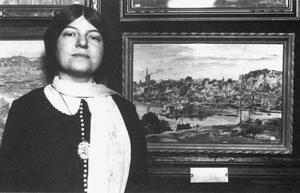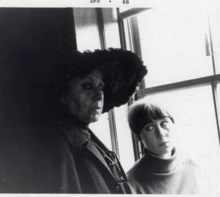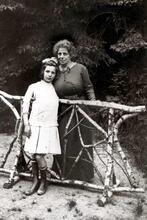Theresa Bernstein
An artist whose career spanned ninety years, Theresa Bernstein was known for her expressive paintings of daily life in the bustling crowds of New York. Bernstein's modernist style and blazing colors were often called masculine by critics, but she often chose to depict women at work and play, from trolley and seashore scenes to suffrage rallies. Bernstein co-founded the Society of Independent Artists in 1916, which allowed any artist to exhibit without juries or prizes. She was a fixture of both the art scene in New York and a respected summer art colony in Gloucester, Massachusetts. Her paintings and prints are now in the collections of museums across the country, including the Metropolitan Museum of Art, the Smithsonian Institution, and the New York Public Library.
An artistic career lasting over ninety years and spanning the twentieth century might seem a worthwhile achievement in itself, but to Theresa Bernstein, longevity was just “an accident of nature.” Only art mattered. Painter, printmaker, teacher, poet, celebrated raconteur, and art activist, Bernstein was an enduring fixture in the art worlds of New York and the summer colony at Gloucester, Massachusetts.
Early Life and Family
The only child of European immigrants Isidore and Anne (Ferber) Bernstein, Theresa was born in Krakow on March 1, 1890. She graduated from the Philadelphia School of Design for Women (now the Moore College of Art and Design) in 1911 (the college awarded her an honorary doctorate in 1992). The following year, her father, a textile manufacturer, moved the family to New York City. Bernstein rounded out her art education at the Art Students League, where she studied with William Merritt Chase. In 1919, she married artist William Meyerowitz, a Russian emigré. They had one child, a daughter who died in infancy. Meyerowitz died in 1981.
Art Career and Jewish Identity
Although not a formal member of the Ashcan School, Bernstein shared with it a passion for “modern” subject matter, to which she added a radically expressive manner. She embraced urbanism and popular culture with enthusiasm, painting such subjects as the cinema, trolleys and the elevated trains, and Coney Island. She exhibited at the MacDowell Club and had a major show at the Milch Gallery in 1919. Her harbor views and beach scenes painted in blazing Fauve-like color attracted equal interest among the young modernists of Gloucester.
After the 1920s, her reputation waned for many reasons, chief among them a decreased interest in the realistic subject matter. There followed a lifetime of steady, consistent work in her signature style—work that was exhibited, reviewed, and (sometimes) purchased, but that did not achieve great critical acclaim. Renewed interest in Bernstein’s art was sparked by the women’s movement, which recognized the quality and originality of her work and her historic contribution to early twentieth-century American art.
As a woman crossing the gender threshold at the beginning of the new century, Bernstein experienced the excitement of that moment but was not spared the indignity of discrimination. Either paying a reluctant compliment or implying criticism, reviewers often described her work as having a “masculine” style. Whatever the gender construction of her style, she saw as a woman, incorporating into her art types and activities ignored by others, such as women at work, women artists, and suffragist parades.
Although Jewish subject matter was not a specialty of Bernstein’s, her works in this genre are among her most profound and moving. Her tropism for community aspects of life led her to depict such subjects as weddings and synagogue services. An ardent Zionist, Bernstein attended the first Zionist meeting in America in Madison Square Garden in 1923, an experience she transformed into the painting Zionist Meeting, New York (1923, National Jewish Fund). Fully assimilated and completely at ease with American culture, Bernstein nevertheless maintained close touch with her Jewish roots and visited Israel many times. Raised in what she referred to as a secular household, she later took on the greater religious observance of her husband.
Legacy
Works by Theresa Bernstein are scattered across the country in many different venues, from prestigious private collections such as The Manoogian Collection to small personal caches in Gloucester, where, in the early days, she may have bartered a painting for food or fuel oil. The Mannheim, Pennsylvania, post office boasts a Bernstein mural from the 1930s. Major works are also held by the Jewish Museum, the Cape Ann Historical Association, the Museum of the City of New York, the National Museum of Women in the Arts, the Montclair Art Museum, and the Jack S. Blanton Museum of Art at the University of Texas.
Theresa Bernstein died on February 12, 2002, at Mount Sinai Hospital in Manhattan. She was just two weeks shy of her 112th birthday.
Selected Works by Theresa Bernstein
Israeli Journal (1994).
The Journal (1991).
The Poetic Canvas (1989).
The Sketchbook (1992).
William Meyerowitz: The Artist Speaks (1986).
Group Exhibitions
American Women Artists: The 20th Century. Knoxville Museum of Art (1989–1990).
The Genius of the Fair Muse: Painting and Sculpture Celebrating American Women Artists 1875 to 1945. Grand Central Art Galleries, Inc., New York (1987).
New York Themes: Paintings and Prints by William Meyerowitz and Theresa Bernstein. New-York Historical Society (1983).
Painting a Place in America: Jewish Artists in New York 1900–1945. The Jewish Museum (1991).
The Paintings and Etchings of William Meyerowitz and Theresa Bernstein. Cape Ann Historical Association (1986)
The Philadelphia Ten. Galleries at Moore (1998-1999).
One-Person Exhibitions
Echoes of New York: The Paintings of Theresa Bernstein. Museum of the City of New York (1990).
Theresa Bernstein. Smith-Girard, Stamford, Conn. (1985).
Theresa Bernstein: Expressions of Cape Cod and New York, 1914–1972, A Centennial Exhibition. The Stamford Museum and Nature Center (1989).
Theresa Bernstein, People and Places: A Retrospective. The Philadelphia Museum of Judaica (1995).
Theresa Bernstein (1890–): An Early Modernist. Joan Whalen Fine Art (2000).
Theresa Bernstein (1890–): A Seventy-Year Retrospective. Joan Whalen Fine Art (1998).
Burnham, Patricia M. “Theresa Bernstein.” Woman’s Art Journal 9, no. 2 (Fall 1988/Winter 1989): 22–27, and Theresa Bernstein, People and Places: A Retrospective. Exhibition brochure. The Philadelphia Museum of Judaica (1995).
Theresa Bernstein (1890–): An Early Modernist. Exhibition catalog. Joan Whalen Fine Art (2000).
Cohen, Michelle. Echoes of New York. Exhibition brochure. Museum of the City of New York (1990).
Jackson, Girard. Theresa Bernstein. Exhibition catalog. Stamford (1985), and Theresa Bernstein: Expressions of Cape Cod and New York, 1914-1972, A Centennial Exhibition. Exhibition catalog. Stamford Museum and Nature Center (1989).
Kleeblatt, Norman, and Susan Chevlowe. Painting a Place in America Jewish Artists in New York 1900–1945. Exhibition catalog. The Jewish Museum in cooperation with Indiana University Press (1991).
Lozowick, Louis. 100 Contemporary American Jewish Painters and Sculptors (1947).
Who’s Who in American Art (1995–1996): 98–99.
Obituary. NYTimes, February 16, 2002.
Sanford, Cynthia H. Theresa Bernstein (1890–): A Seventy-Year Retrospective. Exhibition catalog. Joan Whalen Fine Art (1998).
“Theresa Bernstein, artist, 111.” Deathwatch website, February 21, 2002.
Jureck, Gretchen. “Theresa Bernstein’s Life Touched Three Centuries.” Suite 101 website, March 8, 2002.





